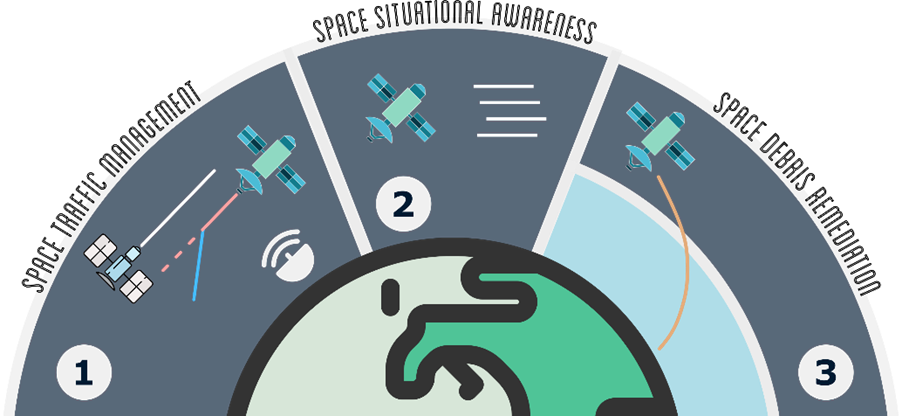The space surrounding our planet is densely populated by space debris, whose number is expected to grow in the next decade due to in-orbit explosions, material deterioration, and in-orbit collisions. Space debris poses a threat to current and future access to space. While objects larger than 5-10 cm can be tracked from Earth and can be avoided through Collision Avoidance Manoeuvres (CAMs), smaller debris are not currently catalogued, therefore statistical distributions are used to quantify the collision risk in different orbital regions and to define mitigation guidelines through long-term evolution models. Moreover, while the design of End-Of-Life (EOL) disposal manoeuvres is desirable to mitigate the number of inoperative satellites, uncertainties related to our limited knowledge of solar activity and its interaction with the atmosphere make accurate re-entry predictions a challenging task.
The e.Cube mission aims at contributing to the advancement of technologies and methodologies for space debris mitigation and remediation. Its scientific objectives are: (1) to increase spacecraft autonomy in performing CAMs, (2) to support space debris modelling with in-orbit collected data about non-trackable fragment objects, and (3) to characterise the atmosphere for more accurate re-entry predictions as well as the thermomechanical loads experienced by the spacecraft during re-entry.
A 12U CubeSat will be deployed in Low Earth Orbit where the operational phase will be dedicated to three experiments. First, the autonomous CAM experiment will perform several CAM tests for simulated close approaches with a virtual debris. For each test, a sequence of conjunction data messages will be generated on ground and uploaded to the spacecraft. The CAM Command Module (CCM) will then decide if and how to perform the CAM using artificial intelligence and fast semi-analytical models. Next, a Particle Detection Device (PDD), exposed in the frontal side of the spacecraft, will collect over one year the highest amount possible of sub-millimetre particles to be used to validate in-use statistical distributions of non-trackable objects. Finally, for the last part of the mission, an EOL manoeuvre leading to a quick re-entry will be implemented. During the re-entry phase, an experiment through the re-entry data collector will characterise the thermosphere in the region below 200 km, through some in-situ measurements, in particular temperature and pressure.

The data and results of the e.Cube mission will be used to validate tools and techniques currently used by the space debris community: long-term evolution models for space debris, re-entry prediction, and autonomous CAM for future space traffic management. In line with the vision of contributing to the international discussion and cooperation on space debris mitigation, all the data and results of the experiments will be freely shared with the debris community to be used for advancing the definition of space debris mitigation guidelines. The proposal describes how the e.Cube mission will be developed. In Phase A/B the three payloads will be defined, designed and a preliminary breadboard will be achieved for on-ground testing through functional payload-in-the-loop tests. Phase C/D to E/F will bring all the proposed technologies and methodologies from TRL 4/5 to TRL 9. The project will benefit from a cohesive consortium primed by D-Orbit who will bring their strong experience in space systems design. As Principal Investigator, Politecnico di Milano (PoliMi) will lead the mission definition and mission analysis and design and will coordinate the payload development. Indeed, the three scientific areas that the mission will demonstrate, namely (1) development of autonomous CAM algorithms, (2) detection and measurement of untraceable space debris, and (3) characterisation of the upper atmosphere and of satellite disposal mechanisms, are also the research pillars of the COMPASS project, where a preliminary model-based demonstration of these concepts was achieved. The CCM will be developed with Intelligentia, who will bring its expertise in the development of on-board software and on-board autonomy. The PDD will be developed exploiting the long-term collaboration between the University of Padova and PoliMi and the experience of the Centro di Ateneo di Studi e Attività Spaziali “Giuseppe Colombo” in hyper-velocity impact testing. The re-entry collector experiment will be built thanks to TEMIS’ expertise in design and production of high-technology equipment for space launchers. The consortium will be supported by a high-profile international panel of scientists and experts in the Space Debris field who will contribute in aligning the development of the payloads with the needs of the debris community for advancing in the definition of internationally recognized mitigation guidelines toward a Sustainable Space Environment.
Publications
- C. Colombo, M. Trisolini, F. Scala, M.P. Brenna, J.L. Gonzalo, S. Antonetti, F. Di Tolle, R. Redaelli, F. Lisi, L. Marrocchi, M. Alberti, A. Francesconi, L. Olivieri, M. Tipaldi, “e.Cube Mission: The Environmental Cubesat,” 8th European Conference on Space Debris, virtual conference – ESOC, Darmstadt, Germany, 20-23 April 2021.
- F. Scala, M. Trisolini, C. Colombo, “Attitude control of the disposal phase of the e.Cube mission for atmospheric data acquisition,” 16th International Conference on Space Operations (SpaceOps 2021), virtual conference, 3-5 May 2021.
- D-Orbit SpA
- Politecnico di Milano
- TEMIS
- Intelligentia
- University of Padova
- Camilla ColomboPolitecnico di Milano, Italy
- Tim FlohrerEuropean Space Agency
- Hugh LewisUniversity of Southampton, UK
- Darren McKnightLeoLabs, CA, US
- Alessandro RossiIFAC-CNR, Italy
